Culture of Syria
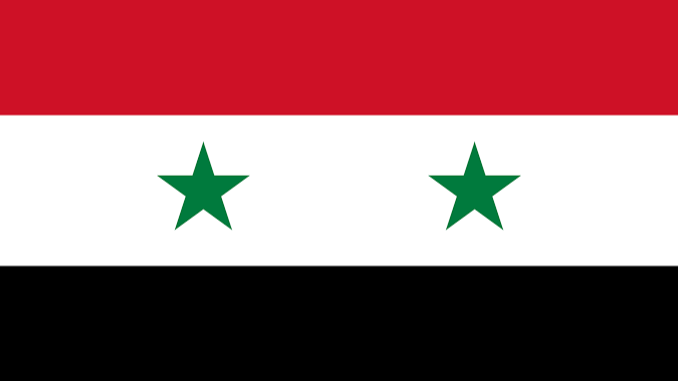
Culture Name
Syrian
Orientation
Identification. Syria is the name that was given to the region by the Greeks and Romans and probably derives from the Babylonian suri. Arabs traditionally referred to Syria and a large, vaguely defined surrounding area as Sham, which translates as "the northern region," "the north," "Syria," or "Damascus." Arabs continued to refer to the area as Sham up until the twentieth century. That name still is used to refer to the entire area of Jordan, Syria, Lebanon, Israel, and the West Bank and has become a symbol of Arab unity.
Location and Geography. Syria borders Turkey to the north, Iraq to the east, Israel and Jordan to the south, and Lebanon and the Mediterranean Sea to the west. It is 71,000 square miles (183,900 square kilometers) in area. One-third of the land is arable, and one-third is pasturable. The terrain is mostly desert, and home to drought resistant plants such as myrtle, boxwood, and wild olive. There is little wildlife. Remote areas have wolves, hyenas, and foxes; the desert has lizards, eagles, and buzzards. Most of the population is concentrated in the western region of the country, near the Mediterranean. Damascus, the capital and the largest city, is located at the foot of the Anti-Lebanon Mountains along the small Barada River. It has a favorable location in a fertile area close to the desert and has historically served as a refueling stop and commercial center for traders making trips through the desert. Inland of this area is a range of limestone mountains, the Jabal al-Nusayriya. The Gharb Depression, a dry but fertile valley, lies between this range and other mountains to the east. The Euphrates River and several of its tributaries pass through Syria, supplying more than 80 percent of the country's water. There are two natural lakes: Arram in the crater of an extinct volcano in the Golan Heights and Daraa along the Jordanian border. There are several artificial lakes created by dams that supply irrigation and electrical power. Most of the country has a desertlike climate, with hot, dry summers and milder winters. What little rain there is falls in the winter, mainly along the coast.
Demography. The population in 2000 was 16,673,282 (not including the 35,150 people living in the Israeli-occupied Golan Heights, of whom 18,150 are Arabs and 17,000 are Israelis). The country is 90.3 percent Arab. Kurds are estimated to constitute between 3 and 9 percent of the population. Also represented are Turks; Armenians, most of whom fled Turkey between 1925 and 1945; and small numbers of Circassians, Assyrians, and Jews. The Bedoins are Arabs, but form a distinct group. They were originally nomadic, but many have been forced to settle in towns and villages.
Linguistic Affiliation. Arabic is the official language, and 90 percent of the population speaks it. The Syrian dialect is very similar to Jordanian and Egyptian and varies little from Modern Standard Arabic, the standardized form used in communications throughout the Arab world. Kurdish, Armenian, and Circassian also are spoken. Kurdish is spoken mostly in the northeast, but even there it is rarely heard, as speaking it is viewed as a gesture of dissent. Some ancient languages are still spoken in parts of the country, including Maalua, Aramaic, and Syriac. As a result of colonial influence, French and English (French in particular) are understood and used in interactions with tourists and other foreigners.
Symbolism. The coat of arms displays a hawk, which is the emblem of Muhammad, the founder of the Islamic faith. The flag consists of three horizontal stripes: red on top, white in the middle, and black on the bottom. In the white section are two green stars, symbolizing Islam.
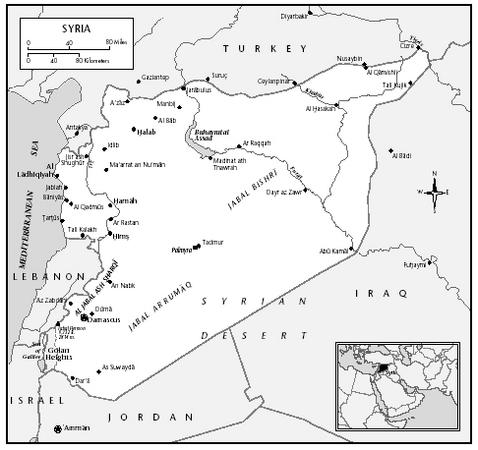
Syria
History and Ethnic Relations
Emergence of the Nation. The modern-day nation emerged from Sham, an area that historically included Jordan, Israel, and Lebanon. Between 2700 and 2200 B.C.E. , this area was home to the Ebla kingdom. Later, the country's strategic location helped its coastal towns rise to prominence as Phoenician trading posts. It was conquered by the Persians around 500 B.C.E. , and by the Greeks in 333 B.C.E. The Romans took over in 64 B.C.E. , and established a fortress at Palmyra whose remains still stand in the desert. Muslim Arabs conquered Damascus in 635 C.E. Beginning in 1095, Syria was a target of the Crusades, but the Arabs ultimately defeated the Christian invaders. The Turkish Ottoman Empire took control in 1516 and ruled the area for four hundred years. That era came to an end in 1920 with the end of World War I, when the French took control of Syria and Lebanon. The French drew a straight-line border to separate this territory from British-ruled Transjordan. Syria had experienced a brief period of independence from 1918–1920, and was dissatisfied with French rule, which ignored the will of the people and did little for the country as a whole. There was a brief insurrection in 1925 and 1926, which the French put down by bombing Damascus.
Syria held its first parliamentary elections in 1932. All the candidates were hand-picked by the French, but once elected, they declined the constitution France had proposed for the country. Anti-French sentiment grew when France turned over control of the Syrian province of Alexandretta to Turkey. It was exacerbated by the promise of independence in 1941, which was not delivered until five years later. After independence, civilian rule was short-lived, and the early 1950s saw a succession of coups, after which Syria formed the United Arab Republic with Egypt in 1958. This represented an effort to keep the Arab states more powerful than Israel, but it disintegrated in 1961, when Syria came to resent the concentration of power in Egypt. The disbanding was followed by further political instability. The situation was worsened by the Six Day War against Israel in 1967 and the Black September disagreement with Jordan in 1970.
Hafez al-Assad, the leader of a radical wing of the Arab Socialist party, the Baath, seized control in 1971. He cracked down hard on dissent and in 1982 killed thousands of members of the the Muslim Brotherhood opposition organization. However, his tight-reined rule averted the civil war and political anarchy that plagued Middle Eastern countries such as Lebanon. In 1992, he won his fourth consecutive bid for election with 99.9 percent of the vote. During the Gulf War in the early 1990s, the country aligned itself with the anti-Iraq coalition, thus winning the approval of the United States and removing itself from the United States' government's list of nations supporting international terrorism. Hafez al-Assad died in June 2000. The younger of his two sons, Bashar, assumed his father's position.
National Identity. Syrians tend to identify primarily with their religious group or sect; however, as the majority of the country is Sunni Muslim, this creates a strong feeling of cultural unity. Modern-day Syria is in part the result of geographic lines drawn by the French in 1920, and there is still a strong pan-Arab sympathy that defines national identity beyond the current borders. The current map was also redrawn in 1967, when Israel took the Golan Heights, a previously Syrian territory, and the national identity is based in part on the concept of defending and reclaiming this land.
Ethnic Relations. Syria is ethnically fairly homogeneous (80 percent of the population is Arab). Religious differences are tolerated, and minorities tend to retain distinct ethnic, cultural, and religious identities. The Alawite Muslims (about a half-million people) live in the area of Latakia. The Druze, a smaller group that resides in the mountainous region of Jebel Druze, are known as fierce soldiers. The Ismailis are an even smaller sect, that originated in Asia. The Armenians from Turkey are Christian. The Kurds are Muslim but have a distinct culture and language, for which they have been persecuted throughout the Middle East. The Circassians, who are Muslim, are of Russian origin and generally have fair hair and skin. The nomadic Beduoin lead a lifestyle that keeps them largely separated from the rest of society, herding sheep and moving through the desert, although some have settled in towns and villages. Another group that remains on the outside of society both politically and socially, is the roughly 100,000 Palestinian refugees, who left their homeland in 1948 after the founding of Israel.
Urbanism, Architecture, and the Use of Space
The focal point of any Middle Eastern city is the souk, or marketplace, a labyrinthine space of alleys, stalls, and tiny shops that also include ancient mosques and shrines. Traditionally, the residential quarters of a city were divided along ethnic and religious lines. Today, this system has been largely replaced by divisions along class lines, with some wealthier neighborhoods and some poorer ones. Damascus is an ancient city, and along with Aleppo, one of the oldest continuously inhabited places in the world. The Great Omayyad Mosque, which dates back to the early days of Islam, is one of its oldest and most famous buildings. It formerly served as a Byzantine church honoring Saint John the Baptist and was constructed on the site of an old temple to pre-Islamic gods. The walls are lined with marble and overlaid with golden vines. Six hundred gold lamps hang from the ceiling. The city is home to ruins as well as intact buildings that date back thousands of years. These structures are located in the area called the Old City. Damascus is also a city of cars, highways, and tall modern buildings made of reinforced concrete.
Aleppo, although smaller, is equally ancient. It is geographically protected by its elevation and rocky terrain, and traces its history back to its days as a fort. Today Aleppo is the nation's second largest urban center and most industrialized city. It engages in silk weaving and cotton printing as well as the tanning of animal hides and the processing of produce. Other cities include Latakia, the country's main port, and Homs and Tartus, both of which have oil refineries.
In villages, houses present a closed front to the outside world, symbolizing the self-contained family unit. They are small, usually with one to three rooms, and are built around an enclosed central courtyard. Traditional rural houses in the northwest are mud structures that are shaped like beehives. In the south and east, most houses are made of stone. The nomadic Bedouin, who live mainly in the south and east, sleep in tents that are easily transportable.
In 1960, 30 percent of the population lived in cities; in 1970, that proportion was 46 percent; and by 1988, the number had climbed to half. Most of this growth has been concentrated in Damascus. The rapid spread of that city into nearby farmland has resulted in traffic congestion, overtaxed water supplies, pollution, and housing shortages. Many older buildings have been taken down to make room for roads and newer structures. The outskirts of the city have become overrun with quickly and shoddily constructed homes that sometimes have electricity but rarely have running water or sewage facilities.
Food and Economy
Food in Daily Life. Wheat is the main crop and one of the staple foods. Vegetables, fruits, and dairy products also are eaten. Lamb is popular, but most people cannot afford to eat meat on a regular basis. Islam proscribes the consumption of pork, and other meats must be specially prepared in a method called halal cooking. In middle-class and wealthier homes, meals are like those eaten in other Middle Eastern countries: roast or grilled chicken or lamb with side dishes of rice, chickpeas, yogurt, and vegetables. A mezzeh is a midday meal composed of up to twenty or thirty small dishes. These dishes can include hummous , a puree of chickpeas and tahini (ground sesame paste); baba ganouj, an eggplant puree; meat rissoles; stuffed grape leaves; tabouleh (a salad of cracked wheat and vegetables); falafel (deep-fried balls of mashed chickpeas); and pita bread. Olives, lemon, parsley, onion, and garlic are used for flavoring. Popular fruits that are grown in the region include dates, figs, plums, and watermelons. Damascus has a number of French restaurants remaining from the time of colonial rule.
Tea is the ubiquitous drink and is often consumed at social gatherings. Soda is also very popular, as is milk and a drink made by mixing yogurt with water, salt, and garlic. Alcohol consumption is rare, as it is forbidden by the Islamic religion, but beer and wine are available, as is arak, an aniseed drink that also is popular in other Middle Eastern countries.
Food Customs at Ceremonial Occasions. Food is an important part of many celebrations. During Ramadan, each day's fast is broken with an evening meal called iftar. This meal begins in silence and is consumed rapidly. Eid al-Fitr, the final breaking of the Ramadan fast, entails the consumption of large quantities of food, sweets in particular. Food is also a central element at weddings, parties, and other festivities.
Basic Economy. The country supplies almost all of its own food needs. The proportion of the population working in agriculture has decreased significantly from 50 percent in 1970, to 30 percent in the 1980s, to 23 percent today. Despite this decline, production has increased, thanks in large part to the dam at Tabqa, which has allowed for increased irrigation. Half of the workforce is employed in industry and mining. There is less of a gap between the rich and the poor in Syria than there is in many other countries, and as more of the population gains access to education, the middle class continues to expand.
The basic unit of currency is the pound.
Land Tenure and Property. Before independence, urban landlords controlled the countryside, often mistreating the peasants and denying them any rights. The majority of peasants worked as sharecroppers and were economically and politically powerless. When the socialist Baath Party took control, it introduced measures to limit and redistribute land ownership and establish peasant unions. It also set up local governing organizations and cooperatives, that have allowed the peasants to attain more control of their lives and livelihood.
Commercial Activities. The center of commercial activity in each town or city is the souk. People from all walks of life and all ethnic and religious backgrounds come together to buy and sell a wide variety of goods. Spices, meats, vegetables, cloth, traditional handicrafts, and imported products jostle for space in the crowded booths and alleyways. Souks are not just commercial centers but gathering places as well, and haggling is a necessary part of social interactions. Shopping centers and supermarkets exist but have not supplanted this uniquely Arab institution.
Major Industries. The main industries are oil, agriculture, and textiles. Wheat is the largest crop, followed by cotton. Vegetables, beans, and fruits
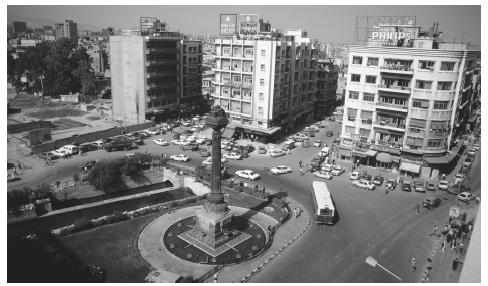
The busy Liberation Square in Damascus. The city is one of the oldest inhabited places in the world, but now it is also a very modern city.
also are grown. There is some heavy industry (metallurgy and aluminum) as well as pharmaceuticals and petrochemicals. The oil industry is controlled by the government. Other manufactures include cement, glass, soap, and tobacco.
Trade. Syria's primary trading partners are Germany, Italy, and France. Although Syria is not as rich in oil as other Middle Eastern nations, oil is the main export, and the exploration for deposits continues. Other exports are cotton, fruits and vegetables, and textiles. Imports include industrial and agricultural machinery, vehicles and automotive accessories, pharmaceuticals, foodstuffs, and fabric.
Division of Labor. Syrians are legally entitled to pursue the career of their choice; however, those choices are often limited by gender, family, social pressure, and economic hardship. There is often relatively little difference in the salaries of the working class and those of the professional class.
Social Stratification
Classes and Castes. Syrian society was traditionally extremely stratified. People from different classes generally do not socialize with one another, and people in the lower classes often adopt a humble attitude and an acceptance of their position. Class lines tend to coincide with racial differences, as lighter-skinned people hold higher economic and political positions and most of the people in the lower-ranked professions are darker-skinned.
The families of landholders and merchants traditionally occupied the highest position socially and politically. They usually lived in Damascus or Aleppo and managed their land from afar. Religious teachers known as ulama were also influential. They served as judges, teachers, and political officials as well as advisers to the government. In this role, the ulama generally supported the status quo. The towns and cities also housed artisans, small merchants, and a small working class.
The Baath government has created some shifts in that pattern. Some peasants are moving to the cities and joining the middle class; others now own land. However, there are still large numbers of indigent and landless peasants. Since the Baath takeover, the army officers who participated in the coup have succeeded the landowners as the new elite. There is also a growing middle class as a result of the spread of education.
Symbols of Social Stratification. The wealthy and well educated have a fairly modern lifestyle with many of the trappings of Western life. Televisions and radios are common except among the extremely poor. Appliances such as air conditioners, dishwashers, and microwaves are only for the very wealthy.
Dress is another indicator of social class. Different tribes and villages have their own distinctive patterns, designs, and colors of clothing. Men traditionally wear long gowns called kaftans, and women wear long robes that leave only their hands and feet exposed. Both men and women wear head wraps. The educated upper classes, particularly the young, tend to prefer modern Western attire. These women favor bright colors, jewelry, makeup, and high heels; men wear dressy slacks and shirts. Blue jeans and T-shirts are rare, as are shorts and miniskirts and bare shoulders or upper arms for women. Traditionally, it is a sign of wealth and status in a family for its women to dress in long robes with their faces veiled.
Political Life
Government. Syria adopted its current constitution in 1973. There is universal suffrage. The unicameral legislative branch is composed of the People's Council, or Majlis al shaab, whose 195 members are elected for four-year terms. This body proposes laws, discusses cabinet programs, and approves the national budget. The president, who serves as the head of state and is required by the constitution to be a Muslim, is elected every seven years by popular vote. The president appoints a vice president, a prime minister who serves as head of government, a cabinet, and deputy prime ministers. The president has wide-reaching powers, including serving on the supreme court. Despite the distribution of political power, in practice, the military government has the ability to overrule all decisions.
Leadership and Political Officials. The importance placed on the family as the central structure in society has ramifications in politics and government. Family loyalty is a primary consideration, and there is a general sentiment that family members (even distant relatives) can be trusted more than other people. The best jobs in the government generally are held by people related to the president, either of the same religious group or the same regional background or part of his extended family.
While residents generally are interested in politics both at a local level and as a part of the larger Arab world and are critical of leaders, they tend not to join political parties. Even the ruling Baath Party has relatively small numbers of members. It is more
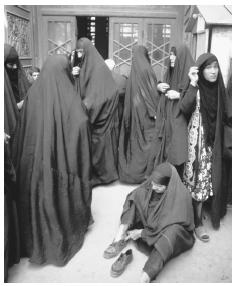
Women outside a mosque in Damascus. Religion is an important part of daily life in Syria.
common to belong to a labor, farm, or professional union or another organization based on family and religion that may have political goals. Within these groups, leadership positions are often hotly contested.
Social Problems and Control. The legal system is based on the French model, with both civil and criminal courts. There is also a State Security Court that tries political opponents of the government. The proceedings of this court violate many international standards for fair trials. There are large numbers of political prisoners in the jails. In 1992, the government announced that it would free 2,864 of these prisoners, perhaps signaling a loosening of its autocratic policies.
For cases dealing with issues such as birth, marriage, and inheritance, the system has different courts for people of different religions. The Muslim courts are called Sharia. There are other ciyrts for Druze, Roman Catholics, Protestants, and Jews.
Military Activity. Syria has armed forces with 408,000 members. This includes an army and an air force but no navy. It spends 30 percent of the national budget on defense as a result of the state of war that has existed between Syria and Israel since the founding of Israel. Syria also has thirty thousand troops stationed in Lebanon to maintain the peace. All men are required to serve thirty months in the armed forces, with the exception of only sons, who are exempt. It is possible to buy exemption from service for a very large sum of money. Women are allowed to serve voluntarily.
Social Welfare and Change Programs
The government strictly enforces price controls on basic items as well as rent control laws, that help low-income people get by. Medical fees are covered by the state for those who cannot afford private care. The government also provides assistance to the elderly, invalids, and those suffering from work injuries. Most assistance comes from within the family structure; young people often live with their parents until and even after marriage, and children are expected to take in and care for their elderly parents.
Gender Roles and Statuses
Division of Labor by Gender. Traditionally, wives in towns are responsible for running the household and are restricted to the home. Rural women often work in the fields in addition to performing domestic tasks. While women are legally allowed to work outside the home, there are significant obstacles. For example, the government's Moral Intelligence Department investigates women before allowing them to hold federal jobs. Only 11 percent of women of working age are employed outside the home; among those women, 80 percent work in agriculture. They also are represented in textiles and the tobacco industry, but only 1 percent of employed women have administrative or managerial positions. There are women in the national government, and in the capital a few women work in metal or electrical workshops. It is not uncommon for women to do piecework in their homes.
The Relative Status of Women and Men. The Baath Party was one of the first in the Arab world to declare as one of its goals the emancipation and equal treatment of women; its constitution of 1964 states that all citizens have equal rights. While women are now entitled to receive the same education as men and to seek employment, the traditional attitude that views females as inferior beings prevails. A woman is considered the possession of a man rather than her own person. She is identified as her father's daughter until marriage; after the birth of a male child, her identity is transferred from the wife of her husband to the mother of her son.
Marriage, Family, and Kinship
Marriage. By Muslim tradition, marriage is arranged by the couple's families. While more leniency is now allowed, particularly in cities and among the upper classes, it is still extremely rare for a couple to marry against their family's wishes. According to the constitution, the state has assumed the duty of protecting and encouraging the institution of marriage. Nonetheless, the marriage rate has declined because of housing shortages, inflation, rising levels of education, bride money, and the prohibitive cost of weddings.
Although the state and the Muslim religion both oppose the current dowry system, it is deeply entrenched in the family structure. It places immense pressure on the husband and his family, who have to raise large sums of money, and on the bride, who often is forced to marry the suitor who can provide the biggest dowry. Syria was the first Arab country to pass laws concerning polygamy. In 1953, it passed the Law of Personal Status, under which a man was bound to demonstrate that he could financially support two wives before marrying the second one. Whereas divorce laws used to follow the Arabic tradition that a man had only to repeat three times "I divorce you" (in his wife's presence or not), court proceedings are now required.
Domestic Unit. The family is the primary social unit. An older male, usually the father or grandfather, has the ultimate authority and is responsible for providing for the other family members. It is customary for several generations to live together in the same house. Particularly for women, who are not allowed to leave the home, family provides the primary or only social outlet and relationships with other people.
Inheritance. An estate passes from the father to the oldest son in a family. Traditionally, not only property is bequeathed, but social and political position as well.
Kin Groups. Syrians identify very strongly with their families, both immediate and extended. While kinship ties have weakened somewhat with urbanization and modernization, the clan mentality is still a strong influence in the nation's political system.
Socialization
Child Rearing and Education. Children are highly valued as a blessing from God. The more children one has, the more fortunate one is considered,
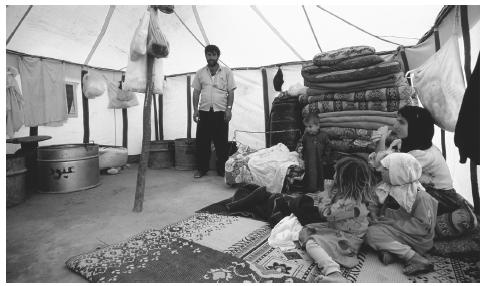
A Bedouin family in their tent in the Syrian Desert. The nomadic people live primarily in southern and eastern Syria.
as children provide extra hands to work in the fields and ensure that their parents will be taken care of in old age. Children are treated with a great deal of affection. The bond between mother and son (especially the oldest son) is particularly strong.
The literacy rate is 64 percent—78 percent for men and 51 percent for women. Primary education is mandatory and free for six years. Middle school, which begins at age thirteen, marks the end of mixed-sex education. Most schools are run by the state, which combines a French structure with the rigid discipline and rote learning of the Islamic tradition. There are a few religious schools, some schools that are run by the United Nation relief program, and some that are run by the Works Agency for Palestinian Refugees.
Higher Education. Syria has vocational and teacher-training education as well as universities in Damascus, Aleppo, and Latakia. About 165,000 students (40 percent of them women) are enrolled in the universities. The learning situation is less than ideal, with large class sizes and outdated teaching and testing techniques. Students who can afford to obtain visas often prefer to study abroad.
Etiquette
Men and women socialize separately except on occasions when the whole family is involved. Talking is a favorite pastime, and the art of conversation is a prized skill. Men often engage in a sort of banter in which they try to one up each other with witty and eloquent insults.
In social interactions, people stand close together, speak loudly, and gesture widely with their hands and heads. Greetings hold great social significance. They are often lengthy, including questions about health. They usually are accompanied by a handshake and sometimes by a hug and a kiss on each cheek. Placing the right hand on the heart when meeting someone is a signal of affection.
Syrians are very affectionate people. Men walk linking arms or holding hands and hug and kiss a great deal, as do women. Close physical contact in public is more common between people of the same gender than it is between girlfriend and boyfriend or husband and wife.
Religion
Religious Beliefs. Seventy-four percent of the population is Sunni Muslim. Sixteen percent belongs
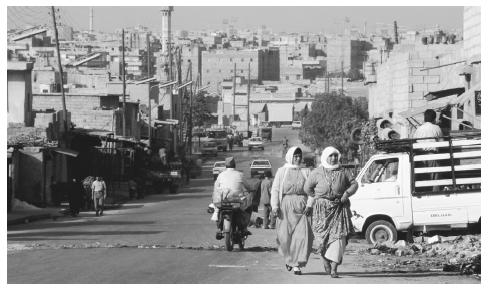
People walking along a street in Aleppo, the nation's second largest city. Protected by rocky terrain, Aleppo was once a fort.
to Alawite, Druze, and other Muslim sects, and 10 percent is Christian. There are small Jewish communities in Damascus, Al Qamishli, and Aleppo. As in many Arabic countries, religion is an integral part of the culture and daily life. The word "Islam" means "submission to God." The religion shares certain prophets, traditions, and beliefs with Judaism and Christianity. The foundation of Islamic belief is called the Five Pillars.
It is speculated, although not certain, that Alawite Muslims do not observe the holy month of Ramadan or make a pilgrimage to Mecca as other Muslims do and celebrate some Christian holidays. The practices of the Druze are also somewhat mysterious. A smaller group known as the Ismailis recognizes a living person, the Aga Khan, as their sacred leader.
The mystical branch of Islam called sufi, has a small presence in Syria, although the government sees this sect as subversive and disapproves of its practice. Sufi rituals involve chanting and dancing while moving in a circular formation.
Despite the powerful influence of Islam in people's lives, some elements of folk religion persist. Particularly in rural areas, there is a strong belief in the evil eye as well as in jinn (spirits). There is also a tradition of local saints to whom people pray.
Religious Practitioners. There are no priests or clergy in Islam. Instead, there are people with the job of leading prayers and reading from the Qur'an, the Muslim holy book. The Qur'an, rather than a religious leader, is considered the ultimate authority and holds the answer to any question or dilemma one might have. There are also muezzins who give the call to prayer and are scholars of the Qur'an and spend their lives studying and interpreting the text.
Rituals and Holy Places. The most important observation in the Islamic calendar is Ramadan. This month of fasting is followed by the joyous feast of Eid al Fitr, during which families visit and exchange gifts. Eid al-Adha commemorates the end of Muhammod's Hajj. The mosque is the Muslim house of worship. Outside the door, there are washing facilities, as cleanliness is a prerequisite to prayer, demonstrating humility before God. One also must remove one's shoes before entering the mosque. According to Islamic tradition, women are not allowed inside. The interior has no altar; it is simply an open carpeted space. Because Muslims are supposed to pray facing Mecca, there is a small niche carved into the wall that points to the direction in which that city lies.
Death and the Afterlife. A death is followed by three days of mourning during which friends, relatives,
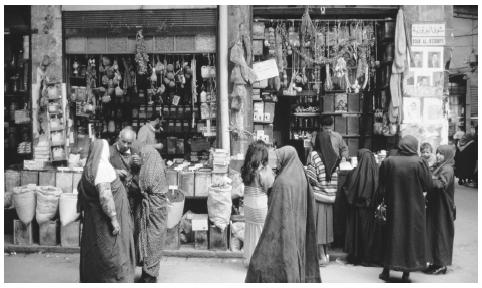
People walk around the bazaar in Damascus. The marketplace is the focal point of every Syrian city.
and neighbors pay their respects to the family. Female relatives of the deceased wear black for several months to up to one year or more after the death. Widows generally do not remarry and often dress in mourning for the rest of their lives.
Medicine and Health Care
There are private medical practices, in addition to the free medical care provided by the state. The health care system is poor but improving. Infectious diseases are a major health threat, especially in rural areas, where water quality is poor and sewage disposal systems are not well developed. There is a high child mortality rate that is due mainly to measles and digestive and respiratory diseases.
Secular Celebrations
The major secular holidays are New Year's Day on 1 January, Revolution Day on 8 March, and the anniversary of the formation of the Arab League, 22 March. Syrians celebrate Martyrs Day in memory of the nation's heroes on 6 April; National Day (also known as Evacuation Day, celebrating independence), on 17 April; and the Day of Mourning on 29 November.
The Arts and Humanities
Support for the Arts. The Ministry of Culture and National Guidance promotes the national culture. Most publishing houses are owned by the state, and writers tend to be government employees. Censorship is enforced strictly, and foreign books about politics and contemporary Syrian or Middle Eastern history are banned. The National Film Centre, established in 1966, oversees the production of most films.
Literature. There is a long literary tradition that dates back to poets such as al-Mutanabbi in the 900s and al-Maarri in the 1000s. Writers must contend with government censorship, but fiction writing is not as tightly monitored as is nonfiction. Whereas the punishment for breaking laws concerning nonfiction is usually imprisonment, fiction writers generally are reprimanded. Perhaps for this reason, poetry and the short story are widely read and appreciated, represented by writers such as Nizar Qabbani, Shawqi Baghdadi, and 'Ali Ahmad Sa'id. There are few women in the ranks of well-known Arab writers, but one of them is Ghada al-Samman, who was born in 1942. She writes on many of the same issues as her male contemporaries, including cultural identity and the clash between tradition and progress as well as issues specific to being a woman and writer in a male dominated society.
Graphic Arts. Islam forbids the artistic depiction of animals or human beings. Therefore, Syrian art until World War I consisted mainly of geometric designs in arabesque and calligraphy. These works can be seen in many palaces and mosques. After World War I, Western drawing techniques began to be taught, and fine arts was introduced as a discipline at the University of Damascus. Most sculpture is carved in white marble and often is displayed in palaces and public buildings.
There is a lively tradition of handicraft production. Jewelry, particularly in gold and silver, is popular, as is other metalwork, such as brass and copper plates and bowls. These items traditionally were produced by Syrian Jews, and as their population has diminished, so has this art form. Mosaic woodworking is also practiced and is used in the construction of boxes, trays, tables, desks, and game boards. Damascus is a center of glassblowing and fabric production, including the silk brocade called damask, which was named for the city. The Bedouins are known for their weaving of fabrics, including carpets and prayer rugs made on hand-built looms, and traditional clothing that is painstakingly embroidered.
Films have been produced in Syria since the 1920s. Musicals and light comedies were popular through the late 1940s. During the 1970s, film clubs were important in the resistance to the government, and for this reason they were shut down in 1980. Syria has spawned several internationally regarded filmmakers, including Omar Amirallay and Usama Muhammed, but their films, which deal with social issues, have been banned in the country, or ignored by distribution companies.
Performance Arts. Memorizing and reciting from the Qur'an and from secular poetry is a popular form of entertainment. There is a rich tradition of storytelling that dates back thousands of years. Even today there are coffee shops where men go to drink tea and hear nightly installments of an ongoing saga recited by a professional storyteller.
Arabic music is tied to the storytelling tradition and often recounts tales of love, honor, and family. Technically, it is repetitive and subtle. It uses quarter notes with small jumps in the scale. Classical Arabic music makes use of the oud, an ancient stringed instrument similar to the lute; small drums held in the lap; and flutes. Contemporary music is played by an orchestra that mainly uses European instruments with a lead singer and chorus.
The State of the Physical and Social Sciences
Damascus has a museum for agriculture and one for military history. Aleppo and other important sites have museums of archaeology.
The main challenge in the area of the sciences is that most Syrians study abroad, and many do not return to Syria to work.
Bibliography
Ball, Warwick. Syria: A Historical and Archaeological Guide, 1998.
Beaton, Margaret. Syria, 1988.
Beattie, Andrew, and Timothy Pepper. Syria: The Rough Guide, 1998.
Galvin, James. Divided Loyalties: Nationalism and Mass Politics in Syria at the Close of Empire, 1998.
Hopwood, Derek. Syria, 1945–1986, 1988.
Lye, Keith. Take a Trip to Syria, 1988.
Mulloy, Martin. Syria, 1988.
Quilliam, Neil. Syria and the New World Order, 1999.
Sinai, Anne, and Allen Pollack, eds. The Syrian Arab Republic, 1976.
South, Coleman. Syria, 1995.
Tareq, Ismael Y., and Jacqueline S. Tareq. Communist Movement in Syria and Lebanon, 1998.
Wedeen, Lisa. Ambiguities of Domination: Politics, Rhetoric, and Symbols in Contemporary Syria, 1999.
Winkler, Onn. Demographic Developments and Population Policies in Ba'athist Syria, 1998.
